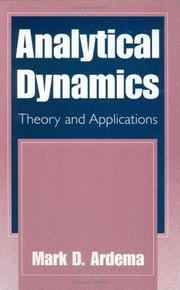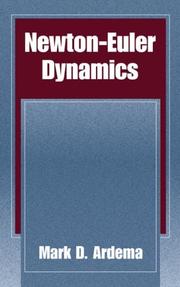| Listing 1 - 8 of 8 |
Sort by
|

ISBN: 128065628X 9786610656288 0306486822 0306486814 Year: 2005 Publisher: New York ; London : Kluwer Academic/Plenum,
Abstract | Keywords | Export | Availability | Bookmark
 Loading...
Loading...Choose an application
- Reference Manager
- EndNote
- RefWorks (Direct export to RefWorks)
In his great work, Mecanique Analytique (1788)-^Lagrange used the term "analytical" to mean "non-geometrical." Indeed, Lagrange made the following boast: "No diagrams will be found in this work. The methods that I explain in it require neither constructions nor geometrical or mechanical arguments, but only the algebraic operations inherent to a regular and uniform process. Those who love Analysis will, with joy, see mechanics become a new branch of it and will be grateful to me for thus having extended its field." This was in marked contrast to Newton's Philosophiae Naturalis Principia Mathematica (1687) which is full of elaborate geometrical constructions. It has been remarked that the classical Greeks would have understood some of the Principia but none of the Mecanique Analytique. The term analytical dynamics has now come to mean the developments in dynamics from just after Newton to just before the advent of relativity theory and quantum mechanics, and it is this meaning of the term that is meant here. Frequent use will be made of diagrams to illustrate the theory and its applications, although it will be noted that as the book progresses and the material gets "more analytical", the number of figures per chapter tends to decrease, although not monotonically.
Dynamics. --- Mechanics, Applied. --- Dynamical systems --- Kinetics --- Mathematics --- Mechanics, Analytic --- Force and energy --- Mechanics --- Physics --- Statics --- Applied mechanics --- Engineering, Mechanical --- Engineering mathematics --- Engineering. --- Vibration. --- Engineering, general. --- Vibration, Dynamical Systems, Control. --- Cycles --- Sound --- Construction --- Industrial arts --- Technology --- Dynamical systems.

ISBN: 1280656743 9786610656745 0387232761 0387232753 Year: 2005 Publisher: New York : Springer,
Abstract | Keywords | Export | Availability | Bookmark
 Loading...
Loading...Choose an application
- Reference Manager
- EndNote
- RefWorks (Direct export to RefWorks)
Most books on this subject are designed for elective courses in "intermediate dynamics" covering advanced Newtonian and introductory Lagrangian methods. Such books do not give adequate emphasis to advanced topics in Newton-Euler dynamics. Because the first required course in dynamics usually concentrates on 2-D dynamics, important 3-D problems are left to a further course. Examples are robots, automated manufacturing devices, aerospace vehicles, and biomechanical components. This material cannot be covered adequately in one course if it is to be shared with an introduction to Langrangian methods. This text is devoted to application of Newton-Euler methods to complex, real-life 3-D dynamics problems; it essentially completes this topic.
Dynamics. --- Mathematics. --- Dynamical systems --- Kinetics --- Mathematics --- Mechanics, Analytic --- Force and energy --- Mechanics --- Physics --- Statics --- Math --- Science --- Mechanical engineering. --- Vibration. --- Mechanics, applied. --- Mechanical Engineering. --- Vibration, Dynamical Systems, Control. --- Theoretical and Applied Mechanics. --- Applied mechanics --- Engineering, Mechanical --- Engineering mathematics --- Cycles --- Sound --- Engineering --- Machinery --- Steam engineering --- Dynamical systems. --- Mechanics. --- Mechanics, Applied. --- Classical mechanics --- Newtonian mechanics --- Dynamics --- Quantum theory
Digital
ISBN: 9780306486821 Year: 2005 Publisher: Boston, MA Kluwer Academic/Plenum Publishers, New York
Abstract | Keywords | Export | Availability | Bookmark
 Loading...
Loading...Choose an application
- Reference Manager
- EndNote
- RefWorks (Direct export to RefWorks)
Classical mechanics. Field theory --- Engineering sciences. Technology --- ingenieurswetenschappen --- dynamica
Digital
ISBN: 9780387232768 Year: 2005 Publisher: Boston, MA Springer Science+Business Media, Inc
Abstract | Keywords | Export | Availability | Bookmark
 Loading...
Loading...Choose an application
- Reference Manager
- EndNote
- RefWorks (Direct export to RefWorks)
Classical mechanics. Field theory --- Engineering sciences. Technology --- toegepaste mechanica --- ingenieurswetenschappen --- mechanica --- dynamica
Book
ISBN: 9283514920 Year: 1985 Volume: vol 724 Publisher: London : A.G.A.R.D. (Advisory Group for Aerospace Research and Development),
Abstract | Keywords | Export | Availability | Bookmark
 Loading...
Loading...Choose an application
- Reference Manager
- EndNote
- RefWorks (Direct export to RefWorks)
Avions --- Conception --- Operation aerienne
Book
ISBN: 9780306486821 Year: 2005 Publisher: Boston, MA Kluwer Academic/Plenum Publishers, New York
Abstract | Keywords | Export | Availability | Bookmark
 Loading...
Loading...Choose an application
- Reference Manager
- EndNote
- RefWorks (Direct export to RefWorks)
In his great work, Mecanique Analytique (1788)-Lagrange used the term "analytical" to mean "non-geometrical." Indeed, Lagrange made the following boast: "No diagrams will be found in this work. The methods that I explain in it require neither constructions nor geometrical or mechanical arguments, but only the algebraic operations inherent to a regular and uniform process. Those who love Analysis will, with joy, see mechanics become a new branch of it and will be grateful to me for thus having extended its field." This was in marked contrast to Newton's Philosohiae Naturalis Principia Mathematica (1687) which is full of elaborate geometrical constructions. It has been remarked that the classical Greeks would have understood some of the Principia but none of the Mecanique Analytique. The term analytical dynamics has now come to mean the develop ments in dynamics from just after Newton to just before the advent of relativity theory and quantum mechanics, and it is this meaning of the term that is meant here. Frequent use will be made of diagrams to illus trate the theory and its applications, although it will be noted that as the book progresses and the material gets "more analytical", the number of figures per chapter tends to decrease, although not monotonically.
Classical mechanics. Field theory --- Engineering sciences. Technology --- ingenieurswetenschappen --- dynamica
Book
ISBN: 9780387232768 Year: 2005 Publisher: Boston, MA Springer Science+Business Media, Inc.
Abstract | Keywords | Export | Availability | Bookmark
 Loading...
Loading...Choose an application
- Reference Manager
- EndNote
- RefWorks (Direct export to RefWorks)
Most books on this subject are designed for elective courses in "intermediate dynamics" covering advanced Newtonian and introductory Lagrangian methods. Such books do not give adequate emphasis to advanced topics in Newton-Euler dynamics. Because the first required course in dynamics usually concentrates on 2-D dynamics, important 3-D problems are left to a further course. Examples are robots, automated manufacturing devices, aerospace vehicles, and biomechanical components. This material cannot be covered adequately in one course if it is to be shared with an introduction to Langrangian methods. This text is devoted to application of Newton-Euler methods to complex, real-life 3-D dynamics problems; it essentially completes this topic.
Classical mechanics. Field theory --- Engineering sciences. Technology --- toegepaste mechanica --- ingenieurswetenschappen --- mechanica --- dynamica
Book
Year: 1984 Publisher: Moffett Field, Calif. : National Aeronautics and Space Administration, Ames Research Center,
Abstract | Keywords | Export | Availability | Bookmark
 Loading...
Loading...Choose an application
- Reference Manager
- EndNote
- RefWorks (Direct export to RefWorks)
| Listing 1 - 8 of 8 |
Sort by
|

 Search
Search Feedback
Feedback About UniCat
About UniCat  Help
Help News
News